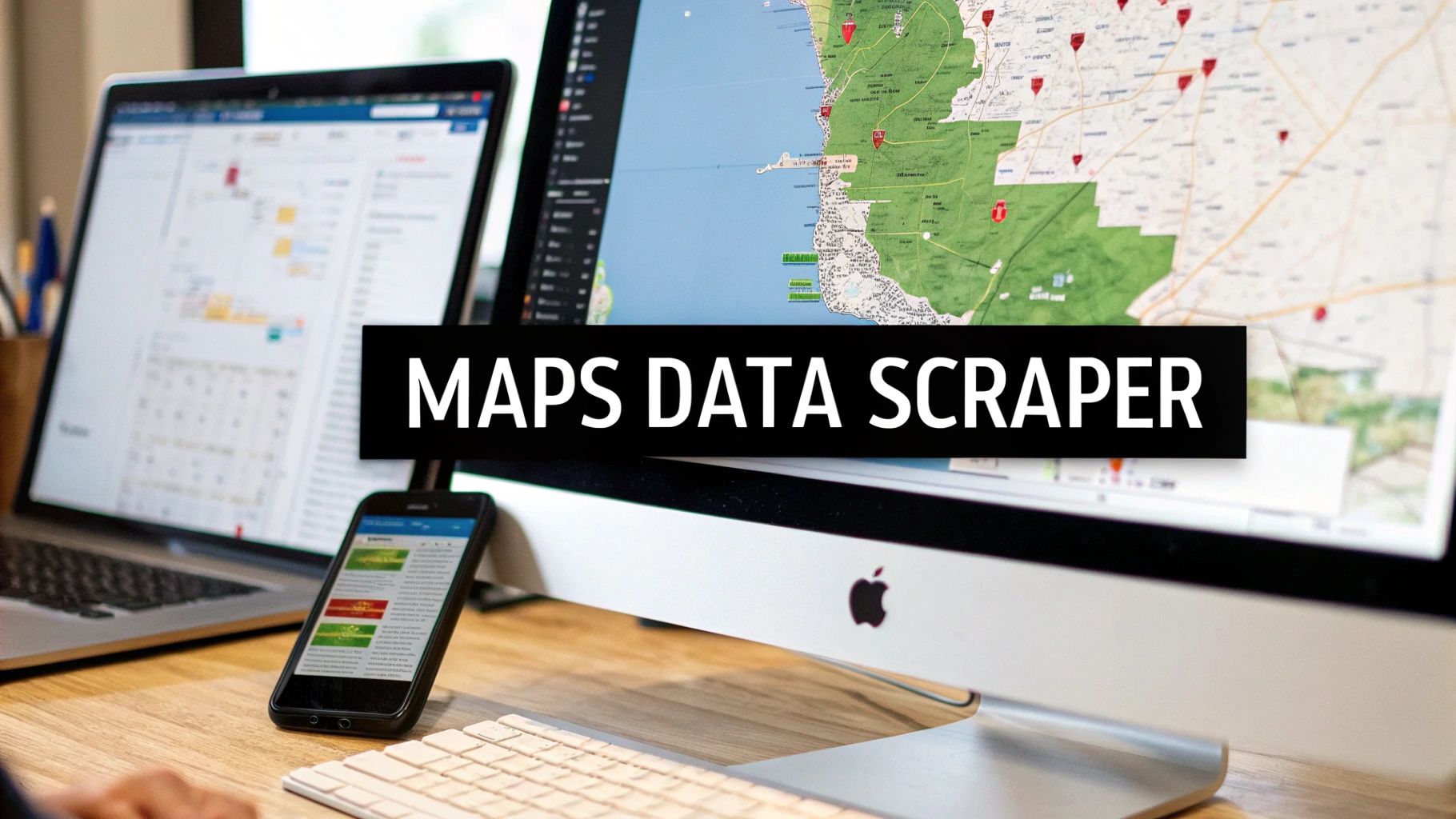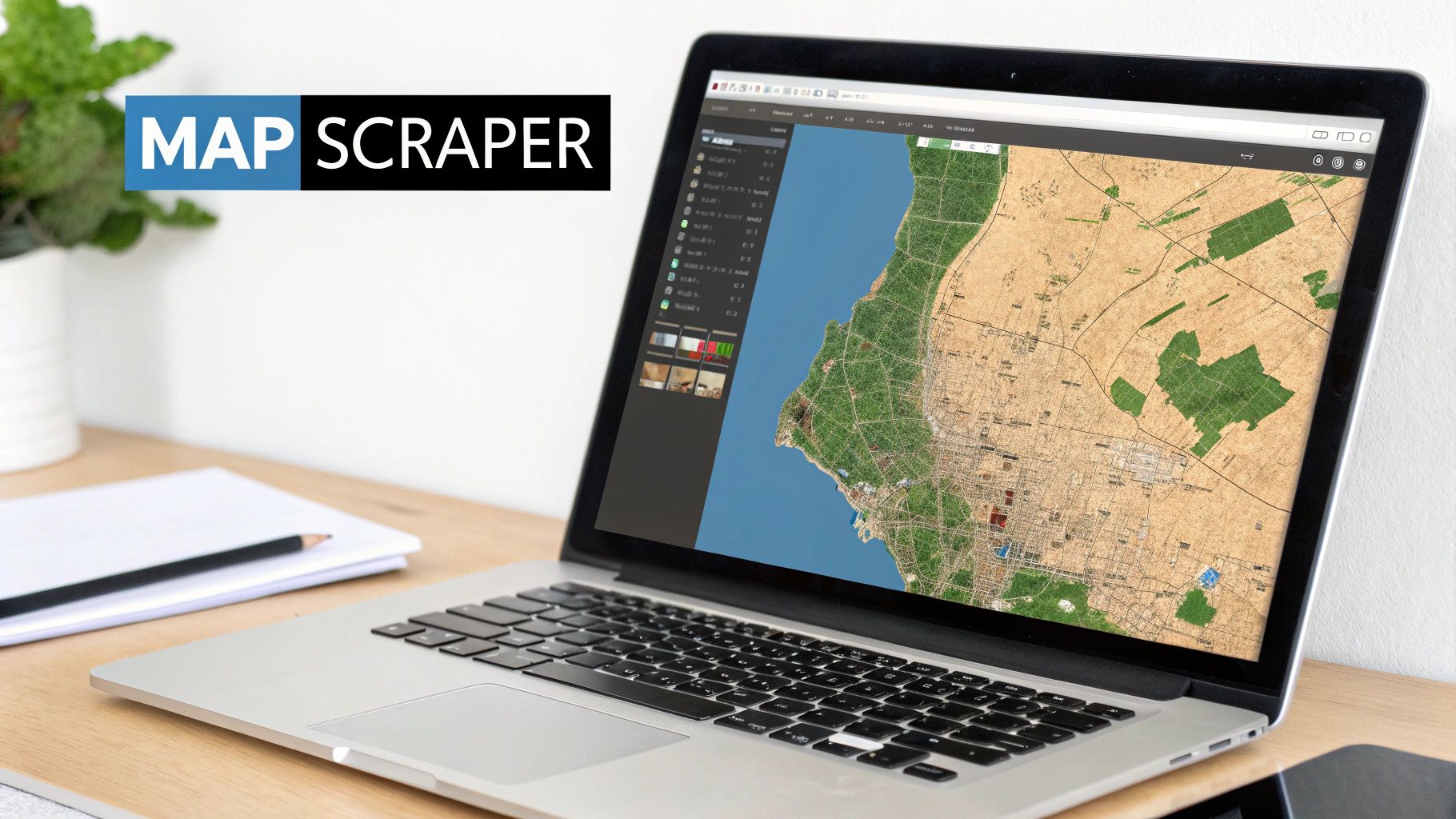Google Maps Data Scraper Guide for Lead Gen

A Google Maps data scraper is a specialized tool that pulls business information—think names, phone numbers, and addresses—right from Google Maps listings. Forget manually copying and pasting. A good scraper can grab thousands of records in just minutes, turning a tedious task into a powerful engine for finding new customers and understanding your market.
Find Untapped Local Leads with a Google Maps Data Scraper

If you're in sales or marketing, you know the grind of finding accurate, local business leads. It's often a mind-numbing manual process, full of errors and wasted hours that could be better spent actually talking to people and closing deals. This is exactly where a Google Maps data scraper can completely change your workflow.
By automating the whole data collection process, you can build laser-focused lead lists for any industry, in any city. Let's say you need a list of every single coffee shop in Chicago or every dentist in Austin. Doing that by hand would take you days. With a scraper? You're looking at minutes.
The Real Power of Pulling Data Automatically
A Google Maps data scraper isn't just a time-saver; it’s a strategic tool for any business looking to quickly find and act on new opportunities. It gives you practical strategies for acquiring new local leads by going way beyond just basic contact info.
When you scrape Google Maps, you get a treasure trove of useful data. Let's look at what that actually means for your business.
Actionable Data You Can Scrape from Google Maps
The information you can pull from Google Maps listings is incredibly rich. It’s not just about a name and a phone number; it’s about building a complete picture of your potential customers and competitors. Here’s a breakdown of the kind of data you can get and, more importantly, what you can do with it.
| Data Point | Description | Business Application |
|---|---|---|
| Business Name & Category | The official name of the business and what it does (e.g., "Italian Restaurant"). | Instantly identify if a business fits your ideal customer profile. |
| Phone Number & Address | The direct contact number and physical location. | The essentials for any sales outreach, from cold calls to direct mail campaigns. |
| Website URL | The business's official website link. | Perfect for deeper research, finding email addresses, or assessing their online presence. |
| Review Count & Rating | The total number of Google reviews and the average star rating. | Gauge customer satisfaction, identify popular businesses, or spot opportunities to help those with poor reviews. |
| Opening Hours | The listed hours of operation for the business. | Know the best time to call or visit, ensuring your outreach lands at the right moment. |
As you can see, this data allows for so much more than a simple cold call. You can segment entire markets, analyze how crowded a niche is, and get a feel for what customers think—all from one data pull.
The biggest advantage here is the sheer speed and scale. A scraper lets one person do the work of an entire data entry team, creating targeted prospect lists that are fresh, relevant, and ready to go.
The scale of this is massive. As of 2025, the Google Maps ecosystem contains over 200 million businesses worldwide. Modern scrapers access this data live, so you're not working off some stale, outdated directory. The information you get is current and reliable.
Our Chrome Extension Makes Scraping Easy
Throughout this guide, I'll walk you through how to do all of this with a simple, no-code tool. The PandaExtract Chrome Extension was built to make data scraping accessible to anyone, no matter your technical background. It works right inside your browser, turning Google Maps search results into a clean, downloadable spreadsheet.
Instead of messing with complicated software or APIs, you just point, click, and pull the data. If you want to follow along with the examples in the next sections, go ahead and install the extension now. Let's get started turning all that data into real opportunities.
Your First Data Scrape in Under 5 Minutes
Alright, enough with the theory. Let's get our hands dirty and actually pull some data. This is where you'll see just how fast you can go from zero to a ready-to-use lead list. We're talking about getting this done in just a few minutes.
First things first, you need the right tool for the job. We'll be using the PandaExtract Chrome Extension because it's a no-code tool that sits right inside your browser. That means no complicated software installations or wrestling with code.
You'll find PandaExtract on the Chrome Web Store. Installing it is as simple as adding any other extension you've used before—just one click.
Installing and Launching the Scraper
Getting set up is a breeze. Seriously, it takes less than a minute.
- Head over to the PandaExtract page on the Chrome Web Store.
- Click the big blue "Add to Chrome" button.
- Once it's installed, I highly recommend pinning the PandaExtract icon to your toolbar. It keeps the tool handy for when you're ready to start scraping.
With the extension installed and pinned, you're officially ready to go. The setup is done.
Running Your First Search
Let's walk through a real-world example. Imagine you're a marketing agency building a prospect list for a new client who sells high-end equipment to plumbing companies. Your immediate goal is to find every single plumber in San Diego.
You’d start just like anyone else: open Google Maps and type "plumbers in San Diego" into the search bar. As Google populates the results on the left side of your screen, that's your cue.
Now, just click the PandaExtract icon you pinned to your toolbar. The tool's interface will pop up, automatically detecting the list of businesses that Google Maps just showed you.
This diagram breaks down the simple workflow we're following. You define a target, set up the scrape, and pull the data. That's exactly what we're doing right now.
With a single click inside the extension, the magic happens. You'll see it start working its way through the list, grabbing business names, phone numbers, addresses, websites, and even review counts. No more mind-numbing copy-pasting. The tool handles all of that grunt work for you.
The real game-changer here is the speed. You can go from a simple idea—"I need plumbers in San Diego"—to a structured, downloadable list of leads in less than five minutes. This completely changes the dynamic of market research and lead generation.
This simple process proves you don't need a technical background to pull valuable data from the web.
Ready to build your first list? Go ahead and download the PandaExtract extension and follow along. Next, we'll dive into how to refine this initial data pull to make sure you're only getting the most relevant, high-quality information.
Refining Your Scrape for High-Quality Leads

Running a broad search is a decent starting point, but the real magic of a Google Maps scraper lies in its precision. Let's be honest, a massive, untargeted list of businesses is mostly just noise. A truly refined list, on the other hand, is a goldmine. Now that you have a basic scrape under your belt, it's time to fine-tune the process to get the exact information your campaign needs.
Think about it from a practical standpoint. If you're building a list for a telemarketing team, they don't really care about business hours, but they absolutely need phone numbers. For a direct mail campaign, a physical address is everything. This is why customizing your data fields isn't just a feature—it's essential for efficiency.
Configuring for Precision
Inside the PandaExtract extension, you have granular control over exactly which data points you want to collect. Before kicking off a new scrape, you can cherry-pick only the fields that matter for your specific goal.
For example, if your primary objective is cold calling, you could set up the tool to pull just two key pieces of information:
- Business Name: So you can properly address your contact.
- Phone Number: The direct line you need for your pitch.
This simple tweak instantly cleans up your final spreadsheet. It gets rid of all the clutter, letting your team focus entirely on their core task. It’s a small adjustment that makes a massive difference in workflow and productivity.
Bypassing Google's Result Limits
Sooner or later, you'll run into a common roadblock: Google Maps typically caps its search results at around 120 places for any given query in a large area. If you search for something broad like "restaurants in New York City," you won't get a complete list. You'll only get what Google's algorithm deems most relevant, which is a major headache if you're trying to do comprehensive market research.
This is where a simple but incredibly powerful strategy comes into play. Instead of one massive, city-wide search, you break it down into smaller, more manageable pieces.
Don't scrape the city; scrape the neighborhoods. By running multiple, smaller searches for specific districts, zip codes, or even boroughs, you can easily bypass the 120-result cap and build a much more complete dataset.
This one technique gives you a significant edge. While your competitors are settling for a high-level, incomplete overview, you’ll be gathering detailed data from every corner of your target market. It takes a bit more effort upfront, but the payoff is a far richer and more exhaustive list of leads.
A Practical Example of Granular Scraping
Let's stick with our "restaurants in NYC" scenario. We know a basic search just won't cut it. A smarter, more refined approach would look something like this:
- First, scrape "restaurants in SoHo, New York" and export the results.
- Next, run a new search for "restaurants in Greenwich Village, New York" and grab that data.
- Then, continue the process with "restaurants in the Financial District, New York", and so on.
When you're done, you'll have several clean CSV files that can be quickly merged into one master list. This final list will be infinitely more comprehensive than anything a single, broad search could ever hope to produce.
This methodical approach ensures you aren't just skimming the surface. You’re performing a deep dive, uncovering businesses that competitors who rely on basic searches will almost certainly miss. This is how you go from just collecting data to building genuine market intelligence.
Putting Your Scraped Data into Action
Alright, so you’ve run your scrape. That’s the easy part. The real magic happens now, when you take that raw information and turn it into something that actually helps your business grow. A list of data is just a list until you put it to work. This is where your effort starts paying off.
Getting your data out of PandaExtract couldn't be simpler. Once your extraction is finished, you can download your list as a CSV or XLSX file. These are the standard formats, so they'll play nice with just about any spreadsheet software or CRM you're using. One click, and your targeted lead list is on your machine, ready to go.
From Data Points to Business Growth
With that file in hand, you've unlocked a ton of possibilities. This isn't just a spreadsheet; it's a powerful tool for your sales, marketing, and business strategy. You can start using it to find customers and get ahead of the competition right away.
So, what does this look like in the real world?
- Fuel Your CRM: Imagine your sales team logging in Monday morning to find a fresh list of 500 new local prospects already loaded into their CRM. No more mind-numbing data entry. They can get straight to what they do best: building relationships and closing deals.
- Launch a Hyper-Local Direct Mail Campaign: Let's say you run a roofing company. You can pull all the residential addresses in a specific neighborhood you want to target and send them a postcard about a recent job you did nearby. It’s a direct, physical touchpoint that cuts through the digital noise.
- Scout New Territories: Thinking of expanding your business to a new city? Before you even sign a lease, you can map out every single competitor. This lets you see which areas are oversaturated and, more importantly, where the untapped opportunities are.
The whole point is to turn that raw data into a strategic asset. When you connect the scrape to a clear business goal, you're not just collecting information—you're creating genuine opportunities for growth.
Building Your Sales Funnel
Once you have your list of leads, the next logical step is to plug them into a sales funnel. This is how you systematically convert a list of names and phone numbers into paying customers. For some great strategies to double your leads, it's worth checking out proven frameworks that guide prospects from initial contact to a closed sale.
The entire process, from that initial Google Maps search to the final sales call, becomes a repeatable, scalable system. We walk through this entire workflow in our guide on how to scrape Google Maps, which covers the complete journey from start to finish.
The beauty of this approach is that it works whether you need a few dozen highly specific leads or thousands for a massive outreach campaign. The core process stays the same.
Ready to give it a try? Download the PandaExtract chrome extension and see how quickly you can turn a simple data scrape into a real business advantage.
Advanced Scraping for Power Users

Once you've got the hang of basic extractions, it's time to level up. This is where you transform a Google Maps scraper from a simple data grabber into a powerful market intelligence machine. We're moving beyond one-off lists and getting into the strategies that separate the pros from the beginners.
Seasoned users know the real challenge isn't just pulling data; it's getting all the relevant data. This means understanding and outsmarting the platform's built-in roadblocks, especially the big one that trips up most people.
Getting Around Google's 120-Result Limit
One of the most common frustrations you'll hit is a hard cap Google puts on search results. It’s been a persistent issue, and by 2025, it's still the main obstacle. For any single search, Google typically shows a maximum of 120 results.
This isn't just a minor inconvenience; it fundamentally limits how much data you can get from one query. A broad search for a popular category will always be incomplete. For a closer look at how this works, these [details on the 120-result limit](
are really insightful.To get the complete picture, you have to think differently. Forget casting one giant net. Instead, your strategy should be to use multiple, highly specific "fishing lines" to find what's hidden deeper.
Let’s say you search for "HVAC." You'll hit that 120-result wall immediately. A power user, however, breaks it down. They run a series of targeted searches:
- "Emergency commercial HVAC repair"
- "Residential furnace installation"
- "Air conditioning maintenance services"
- "Ductless mini-split installers"
Each of these niche searches taps into a different segment of the market, uncovering businesses that were completely invisible in the broader search. By combining the results, you build a far more comprehensive and valuable master list.
This isn't just about getting more names. It's about finding the highly relevant, often overlooked leads that your competitors—still stuck on basic searches—will never find.
Automating Scrapes for Ongoing Market Intel
The true power of a Google Maps data scraper comes alive with automation. Markets are constantly changing—new businesses pop up, competitors' ratings dip, and services evolve. By setting up scheduled, recurring scrapes, you turn a simple tool into a vigilant monitoring system.
Think about what you could do by automatically running a search every month:
- Spot new business openings in your area and be the first to reach out.
- Track fluctuations in competitor reviews to identify their weaknesses or successes.
- Monitor any pricing information listed on business profiles to stay competitive.
This kind of automated workflow delivers a steady stream of fresh intelligence, letting you adapt quickly and stay ahead. If you're interested in exploring these advanced methods further, check out our complete guide on using a Google Maps data scraper.
By combining smart, specific queries with powerful automation, you can create an unstoppable system for lead generation and competitive analysis. Ready to give it a shot? Download our Chrome extension and start putting this data to work for you.
Answering Your Questions About Google Maps Scraping
When you're first getting started with a Google Maps data scraper, it's natural to have a few questions. I've been in this space for a while, and I see the same key concerns pop up time and time again. Let's tackle them head-on so you can get started with total confidence.
Is Scraping Google Maps Actually Legal?
This is easily the number one question, and it's a good one to ask. The short answer is yes, scraping publicly available information—like the business details you see on Google Maps—is generally legal. Think of it as automating a process you could do manually; you're just collecting data that's already out there for anyone to see.
Where it gets nuanced is in how you use that data. You absolutely must respect privacy laws like GDPR and CCPA. The goal is to collect business information for things like market research or lead generation, not to harvest personal data. Stick to ethical practices, and you'll be on solid ground.
Can I Scrape More Than Just One City?
Of course! A good scraper is designed to handle large-scale jobs, letting you cover huge geographical areas. But here's a pro tip: don't try to run a single, massive search for "all restaurants in the USA." That’s a recipe for incomplete data.
The smart way to do it is by setting up separate, targeted extractions.
- Run one search for New York City.
- Run another for Los Angeles.
- And another for Chicago.
By tackling it city by city or state by state, you ensure the results for each location are thorough. This methodical approach is how professionals build comprehensive national or even global databases from scratch.
The real power isn't just pulling data from one place; it's having a system that can methodically map out every single market you care about, big or small.
Will This Tool Find Email Addresses for Me?
This is another huge one, and it’s important to be realistic here. Google Maps listings themselves almost never include a direct email address. Business owners usually provide a phone number and a website, but they tend to keep their inboxes off the public map, so to speak.
So, while a scraper won't find emails on Google Maps directly, it gives you the next best thing: it gathers the website URLs. This list of websites is gold. It's the perfect starting point for a second step, where you can use a dedicated email-finding tool to crawl those sites for contact information. It’s a classic two-step lead generation workflow that works incredibly well.
Ready to start building targeted lead lists with confidence? With PandaExtract - Ultimate Web Scraper, you can easily and ethically gather the data you need to grow your business. Download our chrome extension and start your first scrape in minutes.
Published on